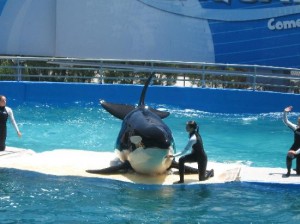Freeing Lolita!
She’s still calling out to her family
A New Beginning for DolphinsPart Three of “Dolphins and Us” A New Beginning for Dolphins Freeing Lolita Could Tilikum Also Be Set Free? Making the Case Is SeaWorld on the Ropes? In the World Spotlight SeaWorld Testifies before Congress Dolfinlandia How You Can Help Interviews & Reports The Case for Dolphin Rights When the Watchdog is Just a Guard Dog Communion in the Wild SEE ALSO: |
 Forty years ago, when she was 3 years old, Lolita was captured from her family and taken to the Miami Seaquarium, where she’s been held ever since.
Forty years ago, when she was 3 years old, Lolita was captured from her family and taken to the Miami Seaquarium, where she’s been held ever since.
Every day — day after week after month after year — she still calls out to her family, thousands of miles away … the same calls that her brothers and sisters, aunts and uncles and all the family use to keep in touch with each other as they dive together in the waters of the Pacific Northwest.
This family of orcas (“killer whales”) is smaller than it once was – several of Lolita’s brothers, sisters and cousins have also been captured and distributed to amusement parks around the country. For the first 10 years of her captivity, one of them lived with Lolita at the seaquarium. (We know they were from the same family since they used the same dialect to communicate.) Then the other orca died, and Lolita has been alone ever since, with only an inflatable plastic orca toy to keep her company.
Still, every day, she performs for the audiences who come to the seaquarium, bringing their children to get “an up-close experience of animals in the wild.”
Lolita, who was first known as Tokitae, meaning “Beautiful lady of shining waters” in the local Chinook language, is the oldest orca in captivity. But that doesn’t mean she’s too old to be set free and returned to her family. Howard Garrett, founder of the Orca Network, has been campaigning for her release since 1995.
“There’s a nice little bay,” he explains, describing a cove that was once netted off for two orcas who had been ordered returned to the wild. “Lolita could be returned there, too, and a care station could be set up, with food, veterinary care, attention and companionship. Her family would typically be coming by any time from late April into October, and they would inevitably hear each other and then we would see.”
Garrett is aware of all the possible contingencies, and his plan takes them into consideration.
“Lolita and her family would have the opportunity to come together and rejoin them and swim away with them. Or there could be a permanent care station available to her at all times so she can come back and be taken care of if that’s what she chooses. It wouldn’t be forced upon her, but I do believe she would ultimately rejoin her family.”
Next: Could Tilikum Also be Set Free?
Related Links:
Miami SeaPrison
Save Lolita
Photos from a recent Let Lolita Live rally outside the Miami Seaquarium.
The Facebook page LLL…Let Lolita Live.
